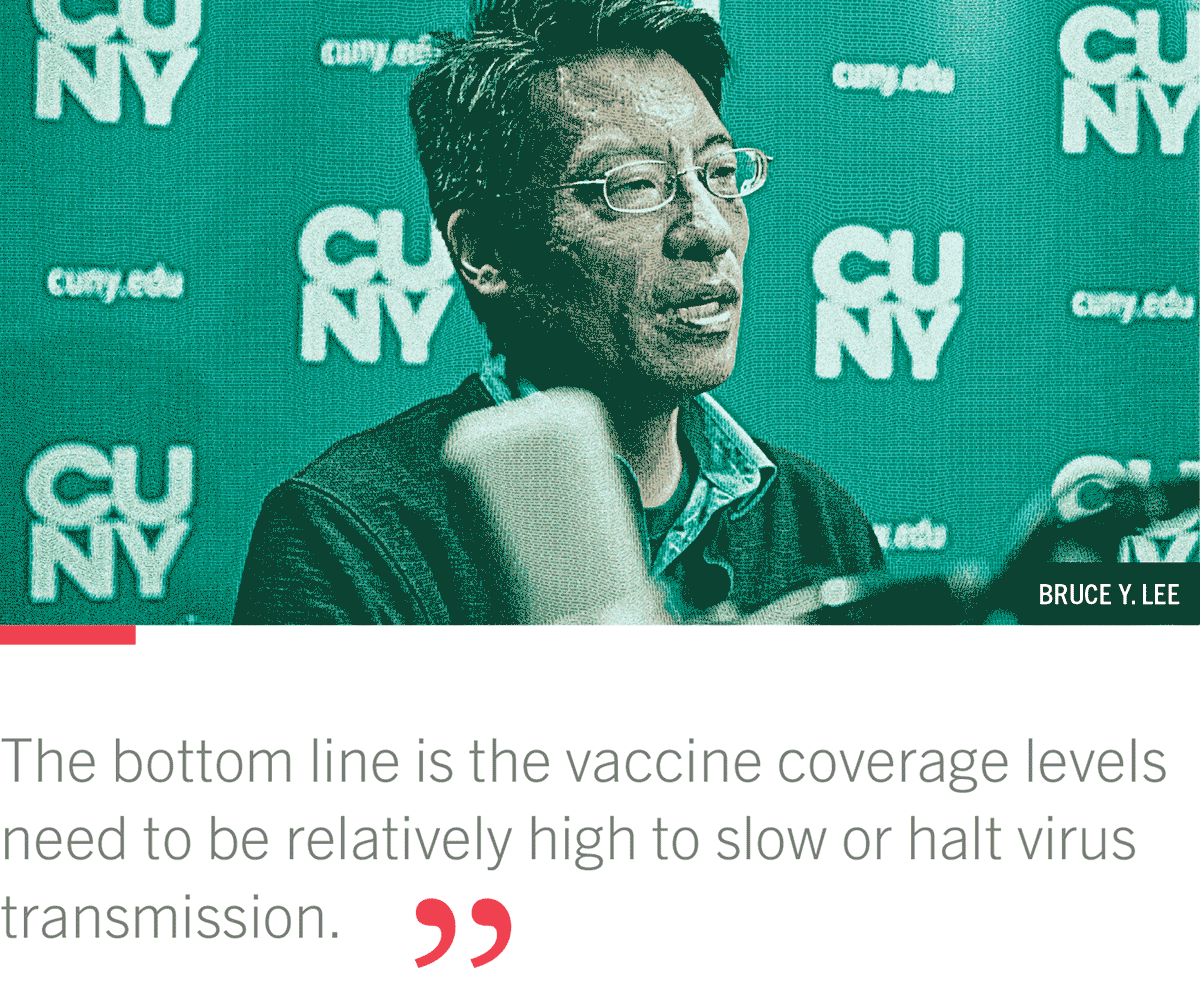
Interactive Model. The model published in this article was also adapted for a New York Times online interactive model.
The emergence and rapid spread of the novel Covid-19 coronavirus in early 2020 spurred numerous accelerated efforts to develop a vaccine. At the time it was not clear how effective these vaccines needed to be to slow or stop the pandemic. The U.S. Food and Drug Administration (FDA) set 50 percent or greater as the target efficacy for the vaccines, but it was not clear then what efficacy levels would be needed to return to normal.
To offer guidance, researchers from Public Health Informatics, Computational, and Operations Research (PHICOR) at the CUNY Graduate School of Public Health and Health Policy (CUNY SPH) worked with the National School of Tropical Medicine and Lundquist Institute at Harbor-UCLA Medical Center to develop a computational model of the U.S. population that simulated the spread and impact of the Covid-19 coronavirus. The model served as a virtual laboratory to test the effect of Covid-19 vaccines with a variety of efficacies, administered in different ways and times to different proportions of the population. This work was deemed paper of the year in 2020 by the American Journal of Preventive Medicine (AJPM) on June 17.
AJPM’s editorial about the paper notes that, “The study’s findings received extensive coverage in major media outlets in the U.S. and internationally, including the Washington Post, Forbes, The Guardian, der Spiegel, CNBC, the Atlantic, National Geographic, WIRED, BuzzFeed, Vox, Newsweek, and many more. The model originally published in this article was also adapted for a New York Times online interactive model to help readers understand the complexity of reaching herd immunity in the U.S. The Article of the Year was shared almost 3,000 times on social media, and the full text of the article has been accessed online more than 25,000 times.”
Prescient vaccine models
“Their study was published in July 2020, well before the actual release of the Covid-19 vaccine in the U.S.,” says Matthew L. Boulton, AJPM’s editor-in-chief. “However, the authors’ research has clearly played a key role in informing national vaccination strategies aimed at bringing the pandemic to an end, as reflected in the paper’s rapidly growing citations in major scientific journals and innumerable mentions in leading media publications and across the social media landscape.”
“In 2020, when the Covid-19 vaccines were still under development, our study showed what efficacy and coverage levels were needed for our society to ‘return to normal’ without precautions such as social distancing and face mask mandates,” says Bruce Y. Lee, senior author of the study, executive director of PHICOR, and CUNY SPH professor. “This is an example of how computer modeling can help guide the design, development and implementation of a new product.”


Equity matters
The relatively high coverage levels needed, emphasize importance of vaccine equity. This research highlights the need for policies and interventions to increase vaccine confidence and acceptance, including communication on the safety and efficacy of vaccines, establishing a clear understanding of the process for FDA Emergency Use Authorization (EUA), creating transparency on vaccine science and research, and engaging communities to increase their access to the vaccine. Moreover, vaccination programs could not just rely on getting the relatively “easy-to-vaccinate” communities covered.
“The bottom line is the vaccine coverage levels need to be relatively high to slow or halt virus transmission,” says Peter J. Hotez, co-author of the study, co-director of the Center for Vaccine Development at Texas Children’s Hospital, and Baylor College of Medicine Professor. “Now that we know we have high performing vaccines, the key will be finding the percentage of the population that needs to be vaccinated to slow or stop Covid-19 spread.”
“The accuracy and relevance of these early findings is testament to the power of computer modeling, as practiced by skilled scientists like Drs. Lee and Hotez,” says CUNY SPH Dean Ayman El-Mohandes. “The simulation of complex systems is now an essential tool in addressing large-scale public health crises.”
Bartsch, Sarah M., et al. “Vaccine efficacy needed for a COVID-19 coronavirus vaccine to prevent or stop an epidemic as the sole intervention.” American journal of preventive medicine 59.4 (2020): 493-503.
Boulton ML. American Journal of Preventive Medicine 2020 Article of the Year. Am J Prev Med. 2021 Jul;61(1):1-2. doi: 10.1016/j.amepre.2021.05.001. PMID: 34148624.
CUNY SPH video AJPM Paper of the Year: https://cunysph.me/AJPM














